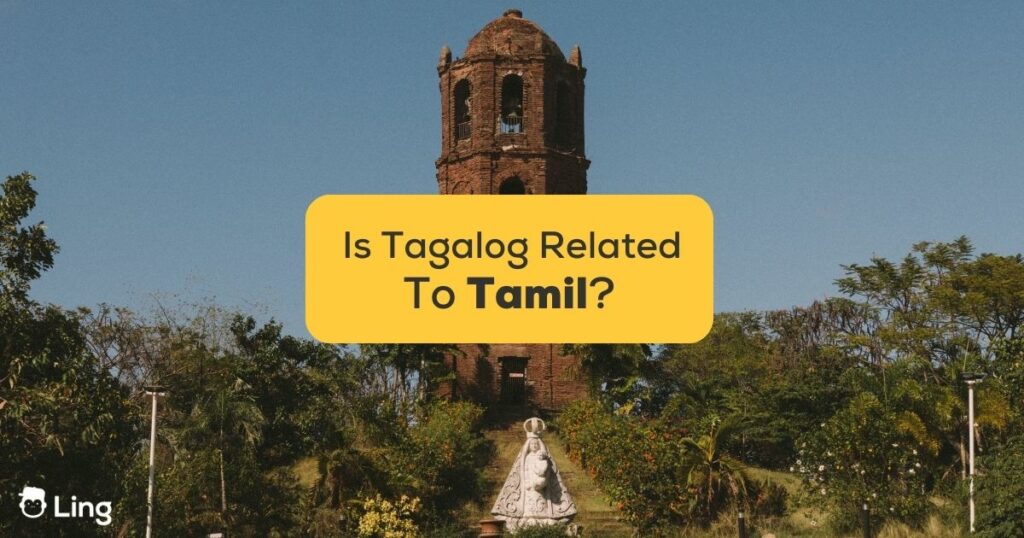“Is Tagalog related to Tamil?” is a question as intriguing as it is unexpected. When it comes to the countless languages that crisscross the globe, a connection between Tagalog, the language primarily spoken in the Philippines, and Tamil, an ancient language from the southern part of India, might not be the first point of comparison that springs to mind. But, as with many good puzzles, the brilliance lies not in the obvious but in the enigmatic.
Picture this: two languages separated by land, sea, and cultural variations, akin to a real-life linguistic Romeo and Juliet. Instead of feuding families, our lovers have ocean currents and vast stretches of terrain standing in the way of their union. Unlike our Shakespearean duo, however, Tagalog and Tamil might not share a tragic (or, in our case, lexical) connection. Their story lies nestled amidst years of history, territorial influence, social interaction, and, of course, human intrigue. Let’s get to the bottom of this in this comprehensive guide!

The Tagalog Language
Tagalog, a language often basked in the limelight due to its national status in the Philippines, has carved out a unique spot in the linguistics world. Embarking on a journey to understand Tagalog is like setting out on an uncharted path woven with cultural richness, intriguing syntactical patterns, and captivating phonology.
Rooted in the Austronesian language family, Tagalog is the first language of approximately 24 million individuals in the Philippines. It is intricately woven into the fabric of Filipino, the country’s official national language—a linguistic masterpiece created in 1937, which fundamentally consists of Tagalog but is also enriched with words from other Philippine languages.
This juxtaposition distinguishes Tagalog from its linguistic counterparts. Nation-building efforts born out of a desire for unity, postcolonial nationalism, and the collective identity of a resilient population have shaped the contours of Tagalog’s evolution.
Delve deeper into its structure, and you’ll discover what truly sets Tagalog apart: its complex verb system. In Tagalog, verbs are modified or conjugated to indicate a focus on the actor, object, or the direction of the action rather than just denoting the time of action (past, present, or future), a feature somewhat alien to many Western language speakers.
Phonetically, Tagalog possesses an impressive array of vowels and consonants, turning any conversation into a symphony of sounds. Remarkably, it has a fairly simple system of stress and no phonemic tone, unlike certain Asian languages – a welcome relief for those navigating the labyrinth of language acquisition.
Tagalog is more than just a language; it’s an indispensable tool for understanding the historical, socio-political, and cultural intricacies of the Philippines. In essence, it’s a vibrant testament to the cultural plurality of the archipelago.
The Tamil Language
Ah, Tamil! A journey into the world of this classical language is nothing short of traveling in a linguistic time machine. Nestled comfortably amidst the Dravidian language family, Tamil is a lustrous gem whose shine reflects on the southern parts of India, Sri Lanka, and a sizable diaspora worldwide.
Imagine holding a time capsule. Ancient, well-preserved, and brimming with secrets of the past. That is what the Tamil language is to around 80 million speakers – a living repository of heritage that dates back over 2,000 years! Yes, that’s not a typo! Tamil was already flourishing while Caesar was still traipsing around Rome.
The charm of Tamil is akin to a well-aged wine—it has depth, complexity, and is undeniably intoxicating. Tamil’s syntax dances to the rhythm of agglutination, making it possible to express complex ideas in a single word. By adding suffixes to root words, Tamil plays with meaning and grammar, much like a seasoned poet experimenting with metaphor.
Tamil’s script offers an equally impressive spectacle. Its rounded characters are more than mere aesthetic pleasure – they tell tales of linguistic evolution, the transition from Brahmi script, and a mark of timeless cultural identity. Like elegant dancers, these letters glide across the page, silent witnesses to the tireless passage of time.
As established from centuries of scholarly discourse, Tamil isn’t a fleeting phenomenon. It’s built the bricks of empires, accompanied exalted literati on their intellectual quests, registered social upheavals, and survived the test of time with admirable resilience. It proudly bears UNESCO’s title of a classical language and embarks on a journey forward, holding its splendid past in its hands.

Is Tagalog Related To Tamil?
In language, as in celebrity dating rumors, not all connections are immediately evident. Yes, indeed there are certain words in Tagalog that sound remarkably Tamil-esque, like ‘mukha’ (face in both languages). Similar? Most definitely. Proof of siblinghood? Not quite.
These overlaps might make you raise an eyebrow, but glimmers of resemblance do not a language family make. You see, languages, like unruly teenagers, are influenced by the company they keep. For a chunk of its history, the Philippines, home of Tagalog, was part of the Indianized Kingdoms – a smattering of Southeast Asian states heavily influenced by India’s culture and languages.
Tamil merchants, being the globetrotters they were, likely left traces of their language around these kingdoms. Like a case of accidental graffiti, these Tamil words found a comfy home in the Tagalog vocabulary. This process, known as “borrowing” in linguistic terms, is why you might spot a croissant in an English breakfast!
So, are Tagalog and Tamil kissing cousins? Probably not. An overlap in vocabulary suggests social interaction rather than a shared linguistic parent. Our language detectives guess that Tagalog and Tamil appear similar because they had a sleepover at the same Indianized Kingdom party some centuries ago.
Learn Tagalog With Ling
Eager to take a leap into the delightful world of Tagalog? Say no more! The Ling app has your back, providing you with an engaging and efficient path to Tagalog fluency. Think of it as your personalized linguistic guide offering the freedom to learn at your own pace, right from the comfort of your couch. Deciphering Tagalog verbs or fine-tuning your pronunciation skills, the Ling app ensures you have all the tools you need to converse like a native in no time.
Tagalog learning is but a few clicks away. Too good to be true, you ask? Put on your exploration hats and embark on your delightful language-learning journey. Why wait when you can start today? Visit your App Store or Play Store, search for the Ling app, and hit ‘Download.’



































































